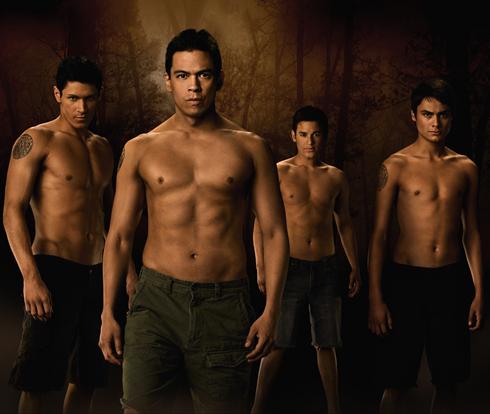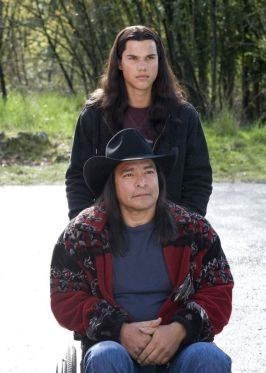Racial and Class Stereotypes in Twilight
Those "Hot" Indians
Jacob, played by Taylor Lautner, may be a teenage heartthrob, but his continual depiction without a shirt shows how over sexualized, exoticized, and macho the fictional Quileute wolfpack is. Meyer describes the sexual, exotic Jacob as having “russet skin…bare-chested, wearing nothing but a pair of old cut-off jeans” (Eclipse, 183, 215). Likewise in the movie New Moon, Bella confronts a shirtless Jacob and his new tattoo, as he stands literally hot and steamy in the rain. Later in the film, as Bella gains more access to the wolf pack, the overly virile, meathead behavior that characterizes the Quileute boys becomes more apparent—out of sheer rage, Paul phases into a wolf and violently brawls with Jacob the wolf, and later at Emily’s house the boys bicker impolitely at the dinner table.
The Classy Cullens
In comparison to the Cullens (with their beautiful mansion, fine clothes, and luxury cars) the Quileute wolf pack and their modest homes, tattered clothes, and lack of shoes seem to represent the lower end of the class continuum. In all of the movies, Jacob shows up at Forks High School to whisk away Bella, curiously never seeming to attend a school of his own. Lack of education aside, the movie Eclipse reduces the esteemed responsibility of Billy Black’s tribal council leadership to the telling of ghost stories around a campfire. Furthermore, The Twilight Saga labels Quileute society with infidelity and broken family structures; Sam’s rise to alpha male stems from the necessity to be unlike his deadbeat dad, and Embry’s wolf “gene” comes from his Makah mother’s illicit affair with an uncertain but married Quileute father (Eclipse, 418). While many of these traits—being poor, uneducated, and having ubiquitous and dysfunctional relationships—are common among all groups of people, The Twilight Saga reinforces these shortcomings as synonymous with the Quileute, and in essence, all Native Americans.
For more on the subject, see Sexism in Twilight Saga and (More) Racism in Twilight Saga.

Cultural Theft in Twilight
Redefining a Culture on Her Terms
The most salient offense of misrepresenting Quileute culture is Meyer’s fabrication of a fictional origin story. In Eclipse, Billy tells of Kaheleha, “the first great Spirit Chief in [Quileute] history,” who used magical animal shape shifting powers to defend Quileute land (Eclipse, 245). The true Quileute origin story differs greatly, wherein Qwati transforms the first Quileute people from wolves.
Such an incorrect representation of Quileute origins is tantamount to altering the creation story of the Judeo-Christian world, and unlike the common knowledge of Genesis, it is a further affront in this instance because the Quileute origin story is relatively unknown. In presenting a real tribe to the far reaches of Twilight’s mass popularity, Meyer has unjustly rewritten Quileute identity into that of magical werewolves.
Everyone Profits Except the Quileute
Summit Entertainment and the ensuing merchandising surrounding The Twilight Saga add insult to Meyer’s injury, not only in visually manifesting and reinforcing the misrepresentation of Quileute traditions, but also in misappropriating Native art in the wolf pack tattoo.
The tattoo, seen on the sculpted shoulders of all the wolf pack boys in the Twilight movies, may not be grounds for visual copyright, as Summit Entertainment hired Canadian artist Lesza Snowdon to design the tattoo, but it does exemplify abuses of cultural appropriation. After visiting La Push and hearing a story about twinning wolves representing strength and solidarity, production designer David Brisbin passed the story on to Snowdon who then featured two wolves in the tattoo.
In addition to appropriating Quileute stories to create the narrative symbolic to the tattoo, Snowdon artistically appropriates Native graphic arts in her tattoo design. Particularly drawing from the Haida form-line style, the tattoo not only takes from Quileute oral traditions, but also does a disservice to all Northwest Coast tribes as it confuses and alters their rich and varied visual culture.
With the pervasiveness of Twilight merchandise at retailers like Dazzled by Twilight, Nordstrom, and Hot Topic, the tattoo has become visually synonymous with the Quileute, all without any approval given or royalties earned by the actual tribe.
Tribe takes on ‘Twilight’ silliness: We ‘do not turn into wolves’


1 comment:
Kahelela sounds Hawaiian, not Indian at all.
What I really don't get is how we're expected to believe that Indians, like Twi-pups, are the only ones who have so many dysfunctional sexual relationships. (Seriously, cheating? Deadbeat dads? Doesn't every culture have those? Even in the ones that punish it so severely that one would have to be insane to do such things, it seems men are immune to punishment.) White Twi-vamps apparently have never had a dysfunctional sexual relationship.
(Could be worse, I suppose. I'm willing to bet an Indian vampire in fiction would be a cannibal necrophile, among other things we associate with vampires in horror stories.)
Post a Comment